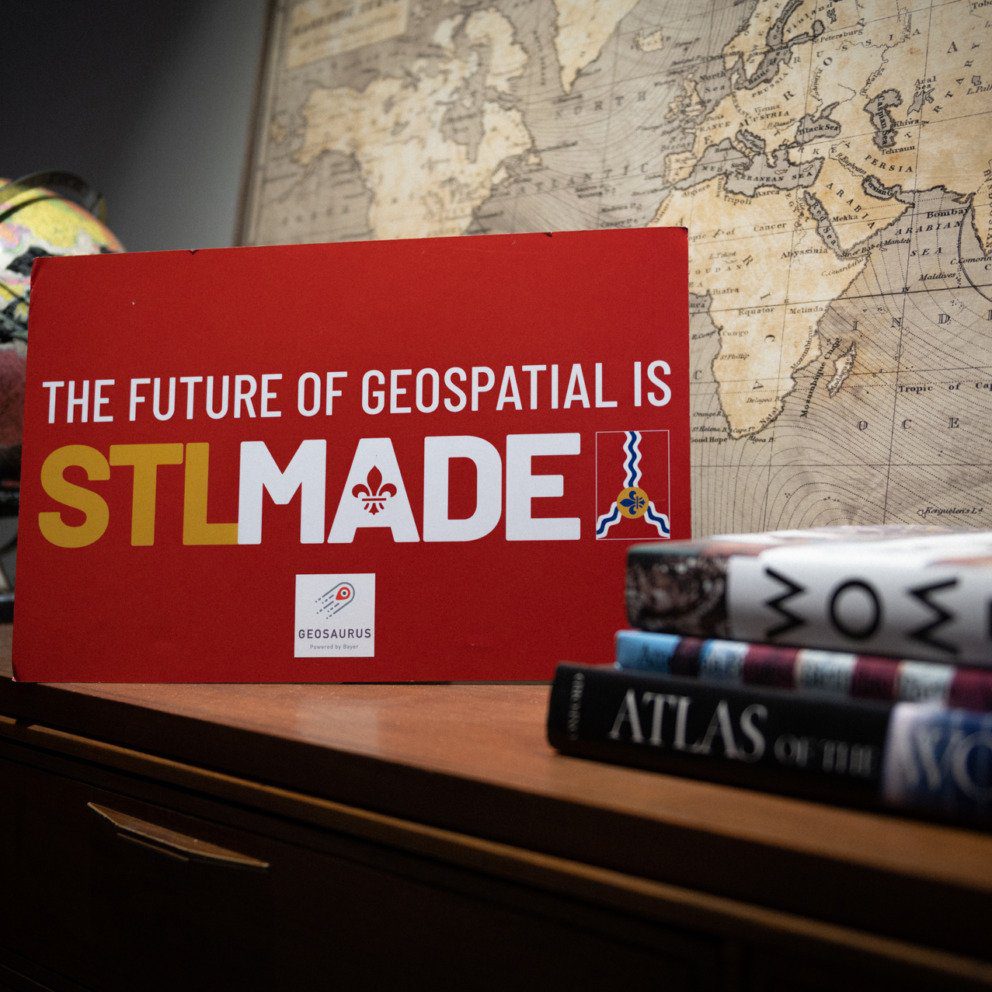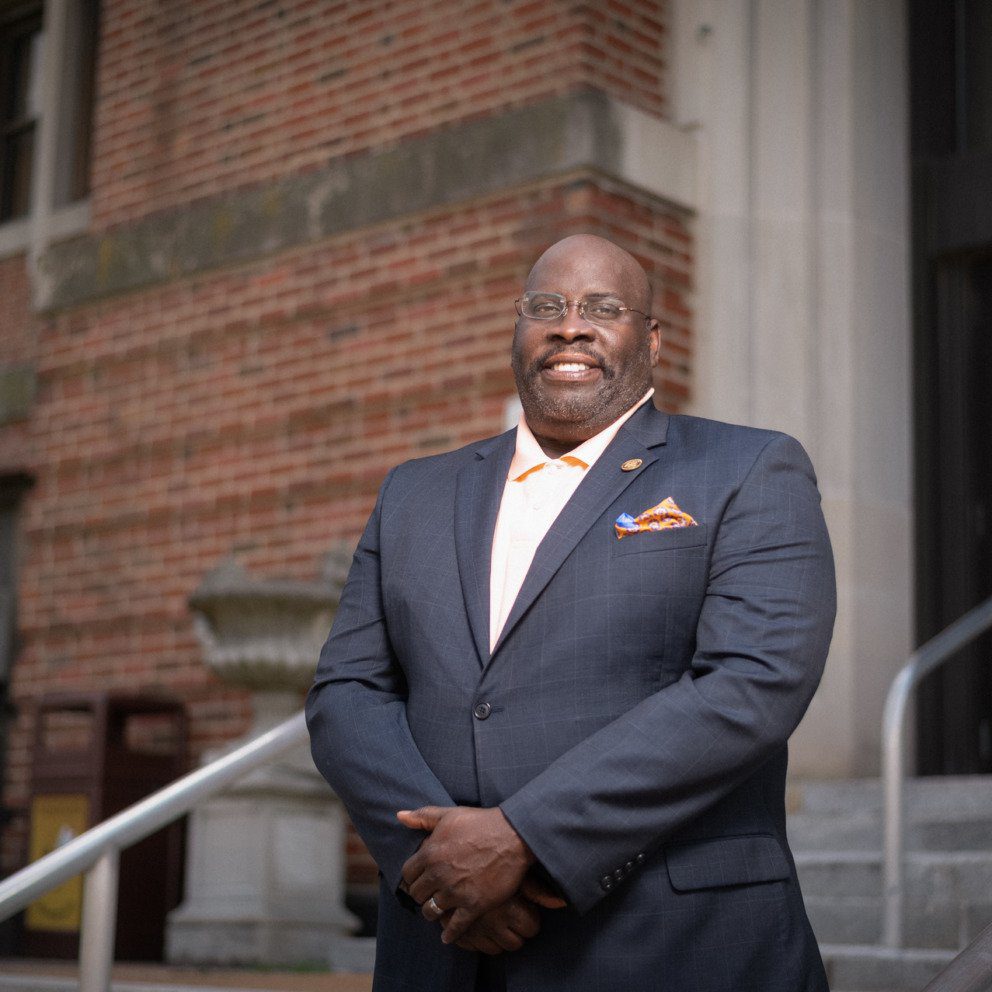Preserving the Past, Shaping the Future
Michael Allen pushes back against the traditional view of preservation, and wants St. Louisans to embrace and appreciate all parts of the region - including those that have been left behind before.
Michael Allen is something of a detective, searching for small clues that explain the past, often in empty spaces. An architectural historian, he says that some places are defined by absence – the memory of what was once there but is no longer.
“To be a detective, you have to know what you’re looking at or what you’re looking for, and then furthermore, why,” he says. “There are traces that still tell a story, sometimes steps and walls. There’s still actual, physical evidence, which is intriguing. And there’s also place knowledge that just doesn’t disappear. You can find people who tell you the stories and point at a vacant lot and talk about their grandparents’ store growing up there or walking to the school that no longer stands, that was right around the corner.”
For Allen, studying and working to preserve St. Louis’ built environment – the streets, homes and commercial buildings that make up our city – is both a career and a passion. As director of the Preservation Research Office and a senior lecturer in architecture, landscape architecture and urban design at the Sam Fox School of Design and Visual Arts at Washington University, he spends most of his time thinking and talking about architecture and its place in St. Louis’ overall past, present and future.
While St. Louis may be best known for the feat of engineering and design that is the Gateway Arch, the region has a long, fascinating history of impressive and diverse architecture that dates back more than a century before Eero Saarinen’s iconic masterpiece was constructed. When it comes to its architectural landscape St. Louis is a true national treasure.
With its makeup of small neighborhoods, each with its own distinct personality and architecture, the city is a patchwork of different architectural styles. From the stately turn-of-the-century mansions of the Central West End and Victorian “painted ladies” of Lafayette Square, to the working class brick row houses of Soulard all the way out to the mid-century modern ranches of the suburbs of Crestwood and Creve Coeur, architecture tells the many stories of our region.
“My background really began with a strong interest in the ways in which cultural narratives and cultural history are embedded in the shape and form of the built environment,” Allen says. “I actually studied literature and history, but I felt this pull to the curiosity for all embedded information in the built environment. So rather than look for stories in books, I ended up in a career where I look for stories in bricks and mortar.”
Bricks, and red ones in particular, play a large role in the creation of St. Louis, which is evident in the buildings and homes of many of the city’s oldest neighborhoods. Local documentary filmmaker Bill Streeter shared its detailed history in his 2011 film Brick by Chance and Fortune, in which Allen was prominently featured.
“We have the red clay soil and this amazing geologic formation called the syncline that’s like a layered pastry of terra cotta, fire clay, coal and the thicker red brick clay that has built up the city,” Allen says. “And it’s really German and English immigrants coming here in the 19th century that were very familiar with brick and knew the clay deposits were here. The earliest brick buildings began here somewhere between 1810 and 1820.”
While some structures of this era still remain intact, the demolition of others has made those bricks a valuable commodity over the decades, and their reuse has been yet another chapter in St. Louis’ architectural history. As an example, Allen notes, following the demolition of the original brick riverfront during the construction of the Gateway Arch, much of that brick was reused in construction in St. Louis County.
“You’ll find brick from the waterfront used in Ladue and other areas where large houses were being built in the middle of the 20th century, often designed by mid-century modern architects like Isador Shank and Harris Armstrong. They were tremendously fascinated with the kind of juxtaposition of the modern form of the old St. Louis red brick,” says Allen.
“When you think about cities that have an abundance of hearty red brick architecture with such elaborate and beautiful detailing – the material culture of our architecture – it’s exquisite. For a Rust Belt, working-class city, it’s drawn up to the highest standards in the world.”
Local architecture blogger and journalist Chris Naffziger wholeheartedly agrees. Naffziger has documented St. Louis’ built environment for more than a decade on his blog, St. Louis Patina, as well as through articles in St. Louis Magazine that explore many of the city’s oft-forgotten architectural gems.
“Having lived in other parts of America and having traveled extensively in Europe, I can guarantee you that St. Louis competes very well against far more expensive and far more famous cities,” Naffziger says.
With an educational background in art history, Naffziger’s broader appreciation of art has informed his passion for architecture and the many different styles exhibited throughout St. Louis.
“Architecture is the most practical of all of the visual arts,” he says. “When I walk and drive around the city of St. Louis, I look at the architecture and it’s not some Byzantine, archaic architecture. It’s architecture for everyday people.”
Naffziger started the St. Louis Patina blog in 2007 as a means of urban exploration and to show people that all parts of the city have value, not just the frequently lauded and most-recognizable neighborhoods.
Both he and Allen have a special appreciation for these lesser-known areas of the city, some that are vanishing and others that have completely vanished, and the greater meaning of why some areas exist in crumbling states in direct juxtaposition to those that remain vital and pristine.
“I’ve spent a lot of my career fighting against the impulse of the profession to ignore places like Downtown East Saint Louis, which I worked on designating as a National Historic District, despite 60 percent of the buildings that were there in 1960 being now gone,” says Allen. “Unfortunately, a lot of the tools for urban renewal are tied to the built environment being designated as a historic place. So if it can’t achieve that designation, financial incentives, historic tax credits aren’t available.”
Through his articles and blog posts, Naffziger pushes readers to question these same topics and more. “I want people to ask why it’s very obvious that some parts of the city get way more tax dollars than other parts of the city,” he says. “Why do some parts of this city have much more investment from real estate professionals and the banking industry while other parts of the city, with the exact same housing stock get absolutely no money?”
It’s not by accident, says Allen, that one end of the city looks one way, and the other looks completely different. “This is a deliberate record of racist redlining practices, denial of credit, the accumulation of the deprivation of resources in one side and the general provision of those resources in another. And so historic preservation has a chance to stop the flow, to stop the historical injustice.”
One such area Naffziger points out is the West End. Not to be confused with the renowned Central West End, the West End is an area north of Delmar Boulevard full of equally amazing homes. Before the Central West End was designated as a Historic District, the combined area was one large neighborhood.
– Michael Allen
“Back in the ’60s, the people in charge decided they were just going to give up on a huge swath of this neighborhood north of Delmar, and they were going to create this new neighborhood called the Central West End. Very few people know about that anymore,” says Naffziger.
This clear division is part of the well-documented “Delmar Divide,” a socioeconomic and racial dividing line that represents a long history of segregation in St. Louis. To historians like Allen, preserving St. Louis’ architectural history means including not just the areas of its greatest pride.
“The whole reason we’re preserving things is to tell the story of this country. So, if we’re omitting the parts that are unpleasant or the record of injustice in the past, well then we’re not telling the full story,” he says. “By inscribing certain things as historic and ignoring the others, we’re deciding what’s still going to be around and whose history then gets told and taught.”
It is the reason Allen has worked hard to gain historic designations for areas such as Saint Louis Place, a near Northside neighborhood along Saint Louis Avenue that dates back to 1850.
“Saint Louis Avenue has the housing stock of Lafayette Square, and Saint Louis Place Park is the only linear park in the city. It’s very pretty, and it’s surrounded by another group of old, large buildings. This is a district people are going to know about, I think, eventually,” Allen says.
Through their work, Allen and Naffziger encourage residents and visitors of St. Louis to explore and appreciate its overlooked neighborhoods, such as Dutchtown on the South Side and Hyde Park, on the North Side.
“Hyde Park is an incredibly beautiful neighborhood with amazing housing stock,” Naffziger says. “I think there is so much potential. It’s a very diverse neighborhood. There is amazing architecture. It’s still in very good shape, but it needs our help in the next 10 to 20 years or it’s not going to still be hanging on.”
In some of St. Louis’ best-rehabilitated neighborhoods, like Lafayette Square and Old North, it is residents and small grassroots neighborhood organizations that facilitate ongoing preservation and change. The all-volunteer Old North St. Louis Restoration Group (ONSLRG) is a community-based nonprofit organization that has worked for almost 30 years to revitalize the community through its award-winning community development corporation. It works with residents and business owners alike and hosts a range of community-building activities including its annual House and Community Tour. Groups like ONSLRG that work in tandem with local governmental entities can make a strong impact within their individual neighborhoods that contribute to the overall success of the region.
“Old North has been tremendously successful with managing multimillion dollar public programs, including 14th street, which was $37 million. You’re not going to be given that money if you don’t have a responsible leadership led organization that has a track record,” says Allen. “So neighborhoods need to organize and stay organized.”
He hopes people will begin to take a stronger individual interest in maintaining the built environment in all parts of St. Louis so it remains accessible to everyone. Meanwhile, he remains hopeful for the city’s overall future.
“St. Louis is starting to be a little bit more on the national map, and I think that’s a good thing; but it’s a reason to start planning for how we’re going to care for this great treasure,” he says. “This great treasure is something that anybody could think of living in, not just somebody with means. That’s important.”
Join the Story
- Learn more about the history of brick in St. Louis by liking the Brick by Chance or Fortune film’s Facebook page. You can also check out the DVD through the St. Louis Public Library, or stream it on Amazon Prime.
- Read more about St. Louis buildings and neighborhoods on Chris Naffziger’s blog, St. Louis Patina.







